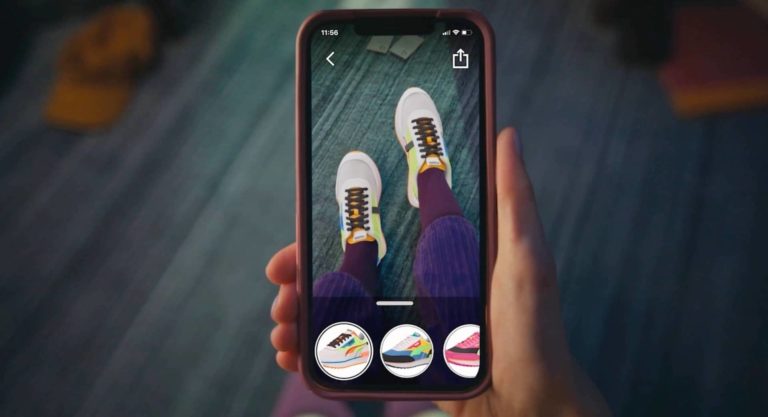
The still-nascent AR sector hasn’t lived up to expectations. That’s mostly because it’s a lot easier to imagine use cases for “phygital” interaction than it is to execute. In reality, there are several technical challenges to get digital content to interact with physical objects realistically.
But there are subcategories gaining meaningful traction, including industrial productivity and brand marketing. The latter continues to add visual dimension – especially in the Covid era – to the product consideration cycle. AR’s performance in that capacity continues to be validated.
But through all that, the biggest eCommerce player of all has been quiet. While Snap, Meta, Pinterest, Wayfair, IKEA, and several others lean into AR (with real revenue results), the king of online shopping has slow-walked it. That includes a few furniture and appliance-based AR trials.
Viral Kick
This all took a different direction with Amazon’s new “Virtual Try-on For Shoes.” Available through a button on supported product pages on iOS, users can – as advertised – digitally try on shoes. The idea is to get a better sense of fit, style, and thus buyer confidence.
From a UX perspective, after tapping the try-on button and activating the camera, consumers point down at their feet to activate the AR try-on. Below the digital shoe rendering in the viewfinder is a carousel to dynamically swipe through colors without exiting the session.
As AR mavens know, this utilizes a key principle known as occlusion. This is all about not only overlaying digital content but doing so in dimensionally-accurate ways (in this case blocking your feet). This is compared with rudimentary AR that’s more about floating stickers.
The new feature also gives users an easy way to snap a photo of the try-on and share it to social media. This is a smart move in that it adds an additional viral kick to propel the new feature. And this is a context that’s naturally shareable, especially among sneakerheads.
For the same reason, shoes are a good candidate for AR-try-ons. They have a combination of nuance in fit and style; and high consideration. This is where an extra confidence boost from dimensional visualization can increase conversions and, notably, decrease returns.
Just like AR isn’t a fit for everything, as noted, its application to product marketing works better in some categories than others. Besides shoes, it’s a hit for furniture because of item bulk. It’s also been popular for cosmetics, especially in during Covid-era retail lockdowns.
Finding its Place
Back to AR’s broader lifecycle, one key lesson of the past few years is that the technology isn’t a silver bullet. Its circa-2017 hype cycle paraded the technology as imminently world-changing on the level of the smartphone revolution. That was a bit overblown… or at least early.
But that’s not to say AR has no value. It’s finding its place in areas like enterprise productivity and brand marketing, as noted. And beyond the technology’s organic fit in specific areas, another factor is cultural acclimation….which always takes time for large-scale behavioral shifts.
This is also a predictable cycle. Over-investment leads to a correction and market shakeout. But rising from those ashes is often measured and meaningful growth. Think of the dot-com boom & bust: all those early high-flying expectations were reached….but not until several years later.
This is all to say that the smartest players are aligning themselves with a gradual AR adoption curve. That gets back to Amazon and how it has slow-walked AR efforts. The same can be said for Apple: Despite all the AR glasses rumors, the tech (and the culture) aren’t ready.
So expect to see more AR from players like Amazon. But don’t expect it to be immediately world-changing. Also, consider that the most successful tech isn’t sexy but mundane. AR will be its best self when it’s a utility – a part of everyday life in ways that we don’t even think about.

